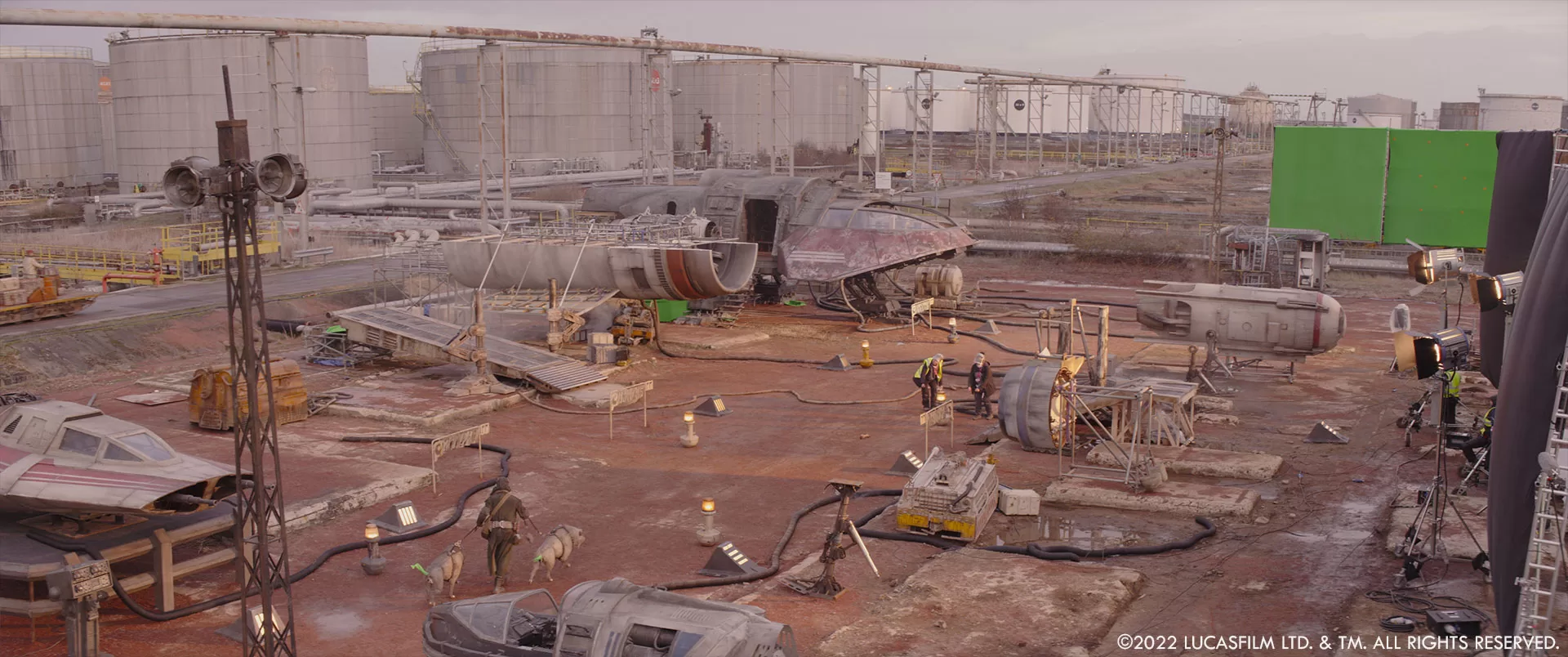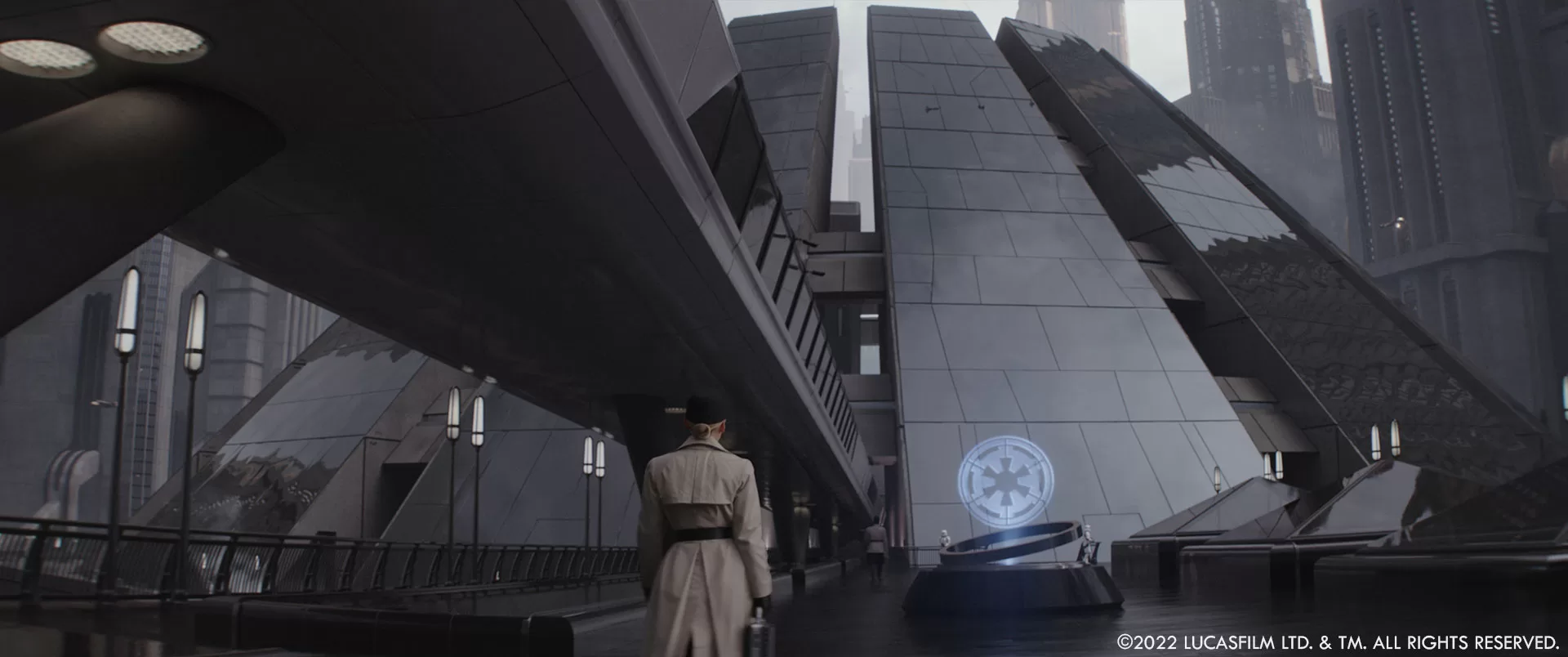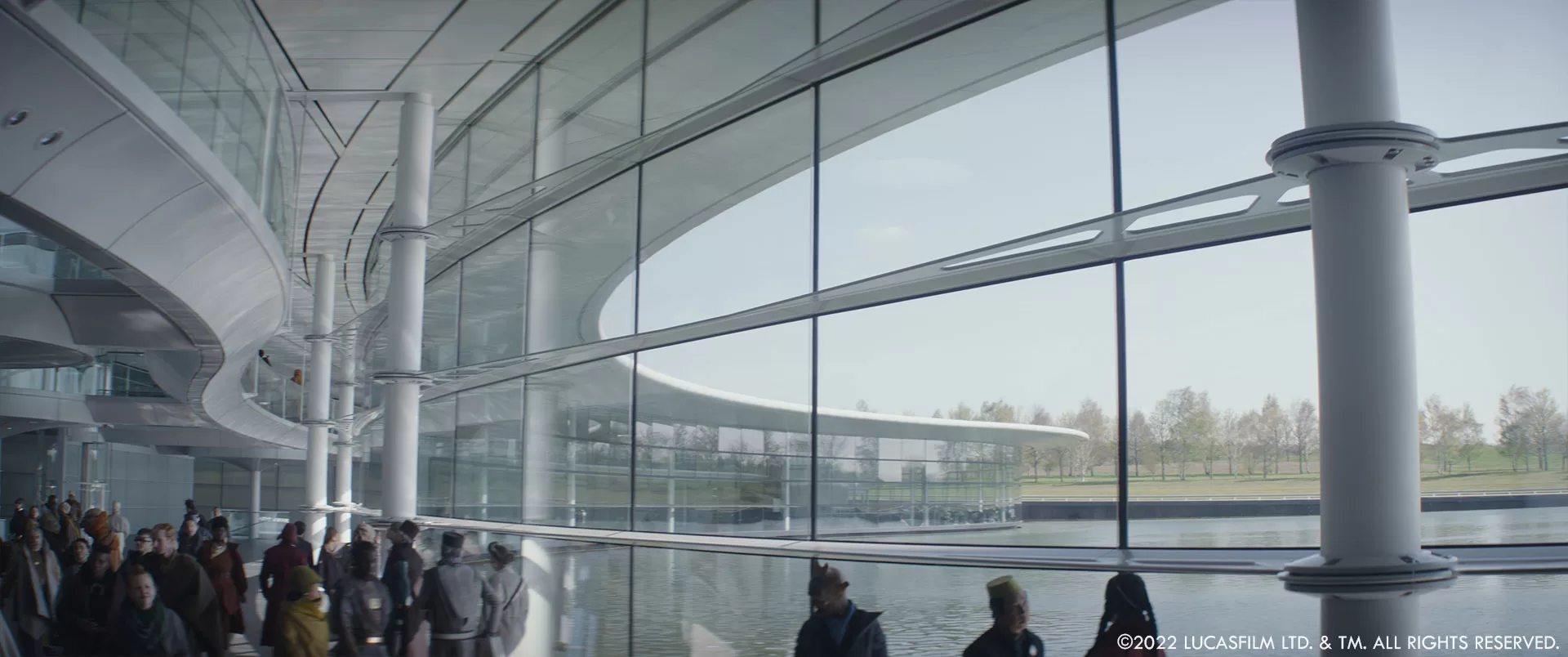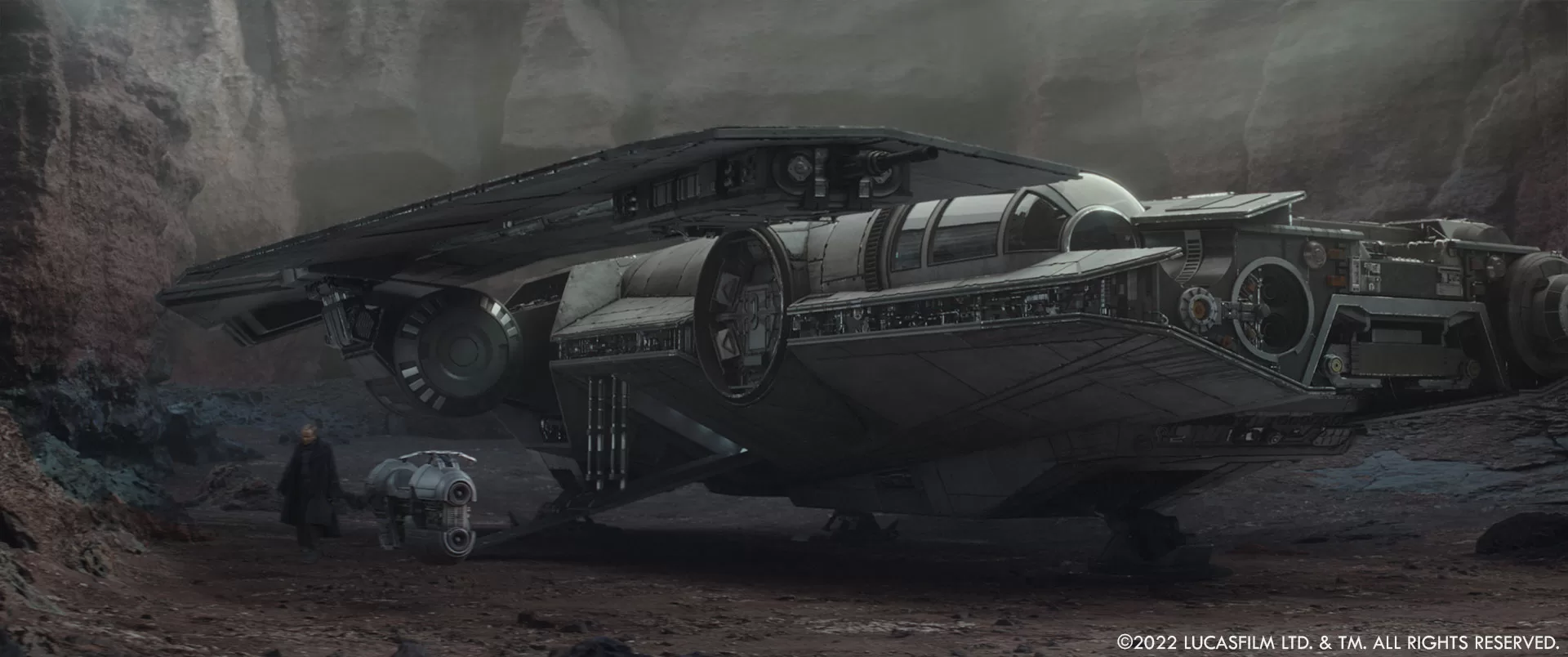Mohen Leo has over 28 years of experience in visual effects. He has worked on many projects such as Poseidon, 2012, The Martian and Rogue One: A Star Wars Story.
Prior to working at Lucasfilm, TJ Falls produced visual effects for projects like Real Steel and Avengers: Age of Ultron. He then worked on shows like Solo: A Star Wars Story, Star Wars: Episode IX – The Rise of Skywalker and Willow.
Before joining ILM in 2014, Scott Pritchard worked in numerous studios such as MPC, Framestore and DNEG. He has worked on many projects like John Carter, Transformers: The Last Knight, Avengers: Endgame and The Stand.
What is your background?
Mohen: I started as a computer graphics artist working on commercials in Germany, before moving to the U.S. where I specialized as an effects simulation artist.
TJ: I grew up in the Los Angeles area and started in production after graduating from UCLA. I’ve primarily worked in production and visual effects on feature films. I’ve had the privilege to be involved with large scale projects with incredible filmmakers that are typically on the cutting edge of visual effects. Those experiences have taught me to always look for creative problem solving techniques and if one doesn’t exist, then create one!
Scott: I started out in VFX as a model maker after graduating from art school, just catching the tail end of the miniature effects era. I then retrained in computer graphics and began working as a compositor for various VFX facilities in London
What is your feeling working in the iconic Star Wars universe?
Mohen: I’ve worked on quite a few Star Wars projects over the years, and one thing that keeps it fresh and fun is that it’s such a huge universe where you can tell all sorts of stories in various genres and styles and media. Every Star Wars project I’ve worked on has been unique and different.
TJ: I feel incredibly privileged to be working in the Star Wars universe. The original trilogy was an instrumental series for me growing up and was a major contributor in what got me into filmmaking initially. Having the opportunity to collaborate and play a pivotal role in the continuation of this universe is something I never take for granted. It’s such a rich universe that each project I’ve worked on feels fresh and new. It is also amazingly rewarding to work on a franchise that has such passionate fans and recognition.
Scott: To work on a Star Wars project is always a privilege, but Andor’s close aesthetic links to the original trilogy meant that this project was something truly special, not least in the way we could reference subtle details from some of the original miniatures and integrate them into our work.


How was the collaboration with the showrunners and the directors?
TJ: Mohen and I worked together with Tony Gilroy on Rogue One so we had a built-in shorthand from the very beginning. We were both involved at the very start, during the initial concepting and during the writer’s room. This early collaboration was instrumental in how we and the other filmmakers crafted the handoff between what was built practically, visual effects, and Tony’s vision for the show. We had three teams of directors and directors of photography on the show. Our collaboration with the directors began from their first day. We worked hand in hand with each team as we created previz for key sequences, led by our previz supervisor Jennifer Kitching from The Third Floor. During the shoot we were with them each step of the way on set, working together to help keep a consistent approach for execution and Tony’ vision.


What was their approach regarding the visual effects?
Mohen: Much like Rogue One, Andor is a story about regular people, not larger-than-life heroes with supernatural powers. Early in the project, Showrunner Tony Gilroy told us that it was really important that our depiction of the Star Wars universe would feel grounded, tangible and relatable. A world where you could imagine people having a job, going to work, living in an apartment. We worked very closely with production designer Luke Hull to make sure that digitally altered or extended environments were always grounded in real locations or extensive partial sets that provided a clear basis for the desired look and lighting of our visual effects work. This grounded aesthetic was then carried forward even into fully computer-generated sequences (like Luthen’s space battle with the Arrestor Cruiser), and we always strived to find real-world reference to anchor our work.


How did you choose the various vendors outside of ILM?
TJ: Star Wars has various signature moments that you expect to see; spaceships, planets, alien locations, etc. Pairing the right vendor with the right work is extremely important to keep a consistent look while upholding the expectations of quality that the Star Wars franchise requires. We knew early on the type of work we needed to accomplish so Mohen and I spent a long time discussing the casting of the vendors and supervisors to undertake that work. This involved numerous conversations, a few tests, and taking the time to be sure we had the right teams involved.
Can you tell us how you split the work amongst the vendors?
TJ: Again, in the vendor casting process we made choices that best fit each vendor. ILM always takes a substantial amount of work on our Lucasfilm projects. We knew early on that ILM, led by supervisor Scott Pritchard, would take point on Coruscant. The Ferrix ship breaking yard also made perfect sense for ILM given the size and scale of the environment while also knowing we’d be looking to reuse ship assets from previous shows. Hybride, with Supervisor Joseph Kasparian, was a natural choice to focus their key work on the Ferrix’s Rix Road. They have an extremely good environment background and have frequently collaborated with us on Star Wars projects. Scanline VFX with supervisor Jelmer Boskma really impressed with their FX experience and took on the challenge of Aldhani, including the Eye of Aldhani sequence. We had an incredibly close collaboration with all our vendors on the show, Rising Sun Pictures with work supervised by Jamie Macdougall, Soho VFX with work supervised by Keith Sellers, and Midas VFX who served as our in house vendor and was led by supervisor Marc Hutchings. Each vendor was assigned sequences that would showcase their strengths and their individual passion really comes through in the work.


Where were the various sequences of the series filmed?
Mohen: Due to covid travel restrictions, all of season 1 was shot in the UK. We had large backlot sets, as well as location photography in Scotland, London, a couple of quarries and a handful of buildings with unique architecture around the UK. The only material shot abroad were the beautiful helicopter plates on Lanzarote that Scott shot, which became the basis for the landscape of Ferrix.
TJ: Our show was shot right in the middle of covid. That restricted our ability to travel to distant locations so most of our work was shot within the UK. Restrictions, however, don’t always hinder and in our case, it focused us to really make specific choices to embrace the locations we were in. Our stage work was based at Pinewood Studios – very familiar territory for Star Wars. Aldhani was shot in Scotland. This was our big location shoot and the Scottish landscape provided the right look and feel for a nomadic countryside that we then augmented with visual effects. The Cruachan Dam was perfect as the basis of the imperial base which gave us a practical structure to shoot and use as the basis of our work. Our Ferrix backlot was built about a half hour from Pinewood in a town called Marlow. This enabled us to have the space to create Rix Road and Ferrix side streets and find the right handoff between what was built and what we would be extending with VFX. We shot in a few other local locations like a quarry in Derbyshire for our Fisherman scene after Cassian and Melshi escape the prison. We did have a plate unit shoot in Lanzarote in the Canary Islands. This was for the Ferrix wastelands and landscape. It was quite challenging to get crew there with covid restrictions. ILM’s Scott Pritchard and Guy Williams led the light and tight unit to shoot stills and helicopter plates that opened up the scope of Ferrix. We really capitalized on great locations like these that Rich Hill, our supervising location manager, found that gave us the tangible feel we were after and provided an anchor in reality for us to base our extension work on.


Can you elaborate about the use of ILM StageCraft on Andor?
TJ: I’m a big believer in choosing the right tool for the right challenge, and what was perfect for our show was a bespoke ILM StageCraft pop up that we used for Mon Mothma’s embassy. We had a number of scenes that took place in the embassy and a variety of looks and different times of day that we needed to achieve. We designed the different looks with Tony and ILM built the environments during pre-production. Once we had the ILM StageCraft LED walls built, we had a pre-light session with both the director and the director of photography so that they could get a feel for the toolset and dial in more specificity to each of the looks they would be shooting. It was a wonderful merging of VFX, set design, and lighting to create an immersive in-camera set.


How did you populate the locations with crowds and vehicles, especially on Coruscant?
Mohen: Nearly all the crowd work on the show used photographic 2D elements. We had a solid understanding of the set extension angles we needed to cover early enough in the shoot to appropriate crowd elements. Only a handful of very wide shots required digital doubles. Flying traffic had to employ CG cars obviously.


How did you handle the variety of lighting conditions for the environments?
Mohen: Our approach of “anchoring” nearly every exterior shot in photographic location and backlot plates, even when environments had to largely be replaced with digital content in post-production, really helped. Given the grounded feel that our showrunner and production designer aimed for, we rarely did sky replacements, embracing the natural weather conditions during the shoot even when it was overcast or foggy, so the lighting we had in the plate could usually dictate the lighting in the digital environment.


How did you create the various spaceships and the iconic TIE fighter?
Mohen: We’re fortunate to have a large catalog of digital assets from previous Star Wars films and streaming shows. With Andor being set very close to the era of Rogue One and Solo, existing models like the TIE Fighter and other ships from that period in the Star Wars timeline could be reused, allowing us to focus our efforts on the new ships like Luthen’s haulcraft.


Can you tell us more about the animation challenges of the spaceships?
Scott: We had a wealth of reference for the flight characteristics of various Star Wars ships, plus the entire sequence had been comprehensively prevised so we were already off to a great start when we started work on this shot. A particular challenge was the way the side cannons deployed on the haulcraft. We knew the cannons had to be hidden from view until the last minute, and the deployment would include the wings folding up into a vertical position. Working out how all these various parts would mechanically unfold was quite a challenge but we landed on the idea of hiding the cannons inside the cylindrical mounts which joined the wings to the fuselage. The wings rotated up and a notch in the inboard wing edge allowed the cannons to poke through, ready to vaporise TIE fighters!


How did you mix practical effects and visual effects for the creatures and droids?
Mohen: Nearly all of the creature and droid work in Andor is practical, created by Neal Scanlan’s team. We only had a handful of shots where we painted out puppeteers or did other little clean-ups. B2 is basically 100% real in every shot. The one obvious exception is the final episode’s mid-credits sequence showing the droids constructing the large structure in space. ILM created that scene completely digitally.


TJ: I’ve worked with Neal Scanlan and his team a number of times. Neal is incredibly thorough in his designs and his creative ideas. Andor doesn’t have an overabundance of creatures and droids – we use them for specific reasons and with specific intention. They also add great texture when giving a scene a particular feel. Neal has this wonderful creature shop where he designs, and his team constructs, the droids and creatures. We would meet often to discuss what he was working on and where we would need to work through any visual effect handoff. During the shoot we work closely with the creature team so that all practical and VFX works seamlessly. That could be working together to hide puppeteers or find creative solutions to any challenges that pop up.


Can you elaborate about the design and creation for the beautiful Eye of Aldhani sequence?
Mohen: The conversations with Tony Gilroy about the look of this sequence stretched over nearly a year before we even shot it. Scanline VFX Supervisor Jelmer Boskma and his team participated in multiple rounds of look development, bouncing ideas back and forth with us. We drew on real-world references like shooting stars, fireworks, long-exposure star trail photography and auroras, as well as the skies in pointillism-style paintings Tony really liked. Finally, an important visual target became extreme close-up photography of the human iris, where (especially in blue eyes) a thin serpentine filigree of complementary colors forms complex beautiful patterns. And then the team at Scanline had to figure out how to turn that look into something that could be simulated and rendered from different camera angles, from up-close and far away, and still maintain a consistent aesthetic. They really did an amazing job.
Can you elaborate on some of the invisible effects?
TJ: There are tons of invisible effects in the show. Our strategy from the very start was to stay grounded and anchored in a reality that would immerse the viewer into a sense that they could imagine living or working or visiting any of the locations we experience. So we challenged ourselves to design the work in a way that we could bring the spectacle of Star Wars into a show without it being specifically gratuitous. That strategy kept us focused on making choices that didn’t showcase the visual effects for the sake of it, but allowed it to blend in and become organic within the storytelling. Every visual effect in the show has a purpose, an intention, and a storytelling point.


Which sequence or shot was the most challenging?
Mohen: Definitely the Eye of Aldhani, and all the credit there really goes to Jelmer Boskma and the amazing team at Scanline for pulling it off.
What is your favorite shot or sequence?
Mohen: For me, it’s a lot of the smaller “casual” shots of Coruscant, where the audience hopefully doesn’t even think about our digital extensions and just accepts this crazy 5000-level city as a real place. ILM did a wonderful job at making the shots beautiful while always keeping the focus on the storytelling.
TJ: This is so hard to answer – so I’ll greedily choose two. The full CG Coruscant establishing shots are really wonderful to me. Our show philosophy is a grounded, reality based approach. We carried that philosophy into our full CG shots as well. The establishers and I’m thinking particularly of the one from episode 4 where we’re looking down into Coruscant – it’s such a typical big city shot and it’s filled with this incredible detail. If this were a modern day show, it’s the same type of shot you’d get of New York, or Tokyo, or London. I love how evocative that typical everyday helicopter photography is and yet we’re seeing Coruscant. It’s exactly the feel that Tony pitched and the restraint of not being overly gratuitous with our effects that leaned into for our show. The other sequence I’ll choose is the Eye of Aldhani. This was a challenging sequence and yet it combined all of the collaborative elements that made the show experience so incredible. All departments played such a pivotal role in the creation of the sequence that it all coalesced into this emotional, awe inspiring, and climactic sequence that I couldn’t be prouder of. It is a great example of how full collaboration can create the spectacular.
Scott: I’ll also choose two 🙂 The space battle between the haulcraft and the Arrestor Cruiser was a real highlight of the show for me. As the Rogue One ILM crew had done, we deliberately leaned into the miniature photography aesthetic for the ships, which was very rewarding personally, having started out in miniatures. Also it was a real honour to bring to life Colin Cantwell’s original Star Destroyer design, in the form of the Arrestor Cruiser. The other sequence I’d highlight is the Eye of Aldhani, I’d seen a couple of early versions of this, but even so I was struck by how beautiful it was to watch, when that episode was released.


What is your best memory on this show?
Mohen: Standing on top of a mountain in the Scottish Highlands at sunset when we were shooting a scene for episode 4. After months of covid lockdowns and travel restrictions, being able to visit such a stunningly beautiful, remote place felt truly special.
TJ: We were on the Ferrix backlot shooting part of the funeral scene in episode 12. We had a VFX element unit shooting off to the side of the backlot and I was reviewing with the team the Lidar scanning plan in one of the building facades. More of my team had come over to review some items so we had a good size group of VFX together. We started to shoot a take so everyone needed to be quiet. The funeral band started playing their music. I took a look down the window of the facade and the team was lined up at the window, masks on, sunglasses on, just taking a moment to watch and listen. Cut was called and everyone swung back into action. I remember just thinking what a perfect moment that was.
Scott: Shooting the helicopter plates on Lanzarote for Ferrix – we had to do a quick test flight to check the weight balance of the camera on the nose of the helicopter. Five minutes into the flight, we realized that the weather conditions were absolutely perfect with low hazy clouds amongst the volcanic craters and calderas, so we decided to shoot as much as we could there & then. What was supposed to be a 10-minute test flight turned into a couple of hours, and we ended up getting about 80% of what we needed.


How long did you work on season 1?
Mohen: TJ and I started in pre-production in late 2019, and finished post-production in mid-2022. The project lasted a bit longer than initially expected due to the pandemic and related delays.
TJ: Mohen and I were both on the project from the very beginning. We started with initial meetings and conversations in 2019 and continued through to the final delivery in mid 2022. We never really stopped though as we were well into prepping Season 2 by the time we closed out Season 1.
Scott: I started on Season 1 in fall 2020 and wrapped mid-2022
What’s the VFX shots count?
TJ: We had a total of 3,853 shots in our show.


What is your next project?
Mohen: Season 2. 🙂
TJ: We started prepping Season 2 of Andor while we were finishing Season 1. Having worked on Rogue One, the opportunity to then work on both seasons of Andor and tell this complete story is truly fulfilling.
Scott: Same here – Season 2!
What are the four movies that gave you the passion for cinema?
Mohen: As far as wanting to work in visual effects, I think Terminator 2 was probably the most influential. I remember that after watching it, I really wanted to learn about how it was even possible to create imagery like that. I had never seen anything like it before.
TJ: Cinema has always played a huge role in my life leading me towards my eventual career. The original Star Wars was a movie (and trilogy) I could watch over and over again and was a huge reason I fell in love with the fantasy that filmmaking could provide. Raiders of the Lost Ark was another pivotal movie that brought me excitement and adventure. Jurassic Park blew me away with imagination, storytelling, and visual effects. Terminator 2: Judgment Day is another film that is so fascinating to watch and rewatch and is incredibly inspirational in its approach to visual effects and cinema at large.
A big thanks for your time.
ANDOR: VFX BREAKDOWNS BY ILM
WANT TO KNOW MORE?
ILM: Dedicated page about Andor on ILM website.
Hybride: Dedicated page about Andor on Hybride website.
Midas VFX: Dedicated page about Andor on Midas VFX website.
© Vincent Frei – The Art of VFX – 2023






